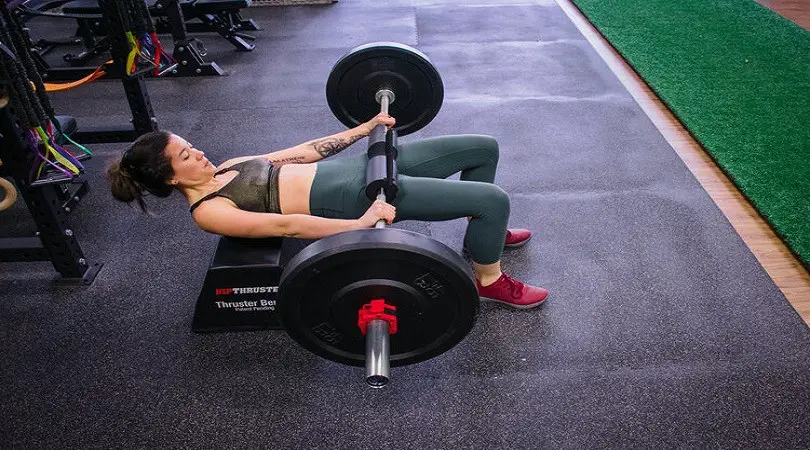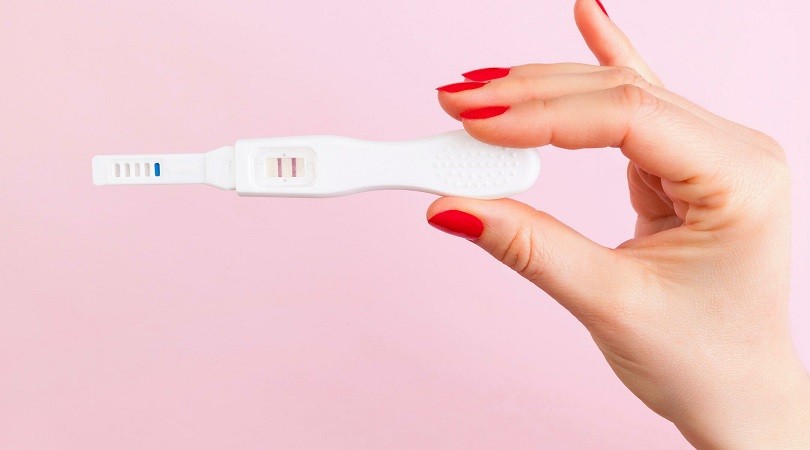Last Updated on January 6, 2025
Yes, you can do hip thrusts while pregnant, but it is important to consult with a healthcare professional before starting any exercise routine during pregnancy. Hip thrusts can be modified to ensure safety and comfort for both the mother and the baby.
Maintaining proper form, using appropriate weight, and listening to your body’s cues are crucial when performing hip thrusts or any exercise during pregnancy. Regular exercise during pregnancy can offer numerous benefits, such as improved strength, posture, and overall well-being. However, every woman’s body is different, so it is essential to work with a healthcare provider to determine the best exercise plan for your individual needs.

Credit: mamastefit.com
Related: Can You Do Jumping Jacks While Pregnant?
Benefits And Risks Of Hip Thrusts During Pregnancy
Can You Do Hip Thrusts While Pregnant?
Many women wonder if they can continue with their regular workouts during pregnancy. One exercise that often comes up is the hip thrust. Known for its ability to target the glutes, the hip thrust has gained popularity in recent years.
However, when it comes to pregnancy, safety is always a concern. We will explore the benefits and risks of doing hip thrusts while pregnant.
Benefits Of Hip Thrusts While Pregnant
- Strengthening the core and pelvic floor: Hip thrusts engage the core and pelvic floor muscles, which can help improve stability and support during pregnancy and prepare the body for childbirth.
- Alleviating lower back pain: Pregnancy can often bring about lower back pain due to the growing belly and shifting center of gravity. Hip thrusts can help strengthen the glutes and hamstrings, providing stability and reducing lower back discomfort.
- Maintaining leg and glute strength: As pregnancy progresses, the added weight and changes in posture can lead to muscle weakness in the legs and glutes. Hip thrusts can help maintain strength in these areas, supporting overall balance and function.
Risks And Precautions For Hip Thrusts During Pregnancy
- Consult with your healthcare provider: Always consult with your healthcare provider before starting or continuing any exercise program during pregnancy. They can provide personalized advice based on your specific needs and medical history.
- Modifications may be necessary: As your pregnancy progresses, modifications to the hip thrust exercise may be required. Different variations or adjustments in range of motion may be necessary to accommodate your changing body and ensure safety.
- Avoid excessive weight or strain: While hip thrusts can be beneficial during pregnancy, it’s important to avoid using excessive weight or straining your body. Listen to your body and focus on maintaining good form rather than pushing yourself to lift heavy weights.
- Be mindful of your comfort level: As the belly grows, finding a comfortable position for hip thrusts can become more challenging. Pay attention to any discomfort or strain, and modify the exercise or try alternative movements if needed.
Remember, every pregnancy is unique, and what works for one woman may not be suitable for another. It’s crucial to prioritize safety and listen to your body throughout your pregnancy journey. Always consult with your healthcare provider before starting or continuing any exercise regimen.
Modifications And Alternatives For Pregnant Women
Safe Modifications For Hip Thrusts During Pregnancy
Pregnancy is a unique time in a woman’s life, and it’s natural to have questions about exercise and what’s safe for both you and your baby. If you’re a fan of hip thrusts and wondering if you can continue doing them during pregnancy, the good news is that with some modifications, you can safely incorporate this exercise into your prenatal fitness routine.
Here are some key points to consider:
- Consult with your healthcare provider: Before starting or continuing any exercise routine during pregnancy, it’s essential to consult with your healthcare provider. They can assess your individual situation and offer personalized recommendations based on factors like your health, stage of pregnancy, and any specific concerns you may have.
- Protect your back and pelvis: As your pregnancy progresses, the hormone relaxin loosens the ligaments in your body, including those in your pelvis. This increased flexibility can make you more susceptible to strains or injury during certain exercises. To protect your back and pelvis during hip thrusts, consider the following modifications:
- Use a lower bench or platform: Opt for a lower bench or platform to reduce the range of motion and minimize stress on your pelvic area.
- Place a cushion or yoga block under your hips: Adding some extra padding under your hips can provide additional support and cushioning, making the exercise more comfortable and safer for your body.
- Listen to your body: During pregnancy, your body undergoes numerous changes, and it’s crucial to pay close attention to how you feel while exercising. If something feels uncomfortable or causes any pain or discomfort, it’s essential to modify or stop the exercise immediately. Always prioritize your comfort and safety.
- Engage your core and glutes: To maximize the benefits of hip thrusts while minimizing strain on your lower back, focus on engaging your core and glute muscles throughout the movement. This conscious activation can help stabilize your pelvis and reduce the risk of injury.
Alternative Exercises For Pregnant Women
If you’re unsure about incorporating hip thrusts into your prenatal workouts or if you simply want to try some other exercises to mix things up, here are a few alternatives that can effectively target similar muscle groups:
- Glute bridge: Similar to the hip thrust, the glute bridge is a great exercise for strengthening your glutes and core. To perform a glute bridge, lie on your back with your knees bent and your feet flat on the floor. Lift your hips off the ground, squeezing your glutes at the top, and then lower back down.
- Squats: Squats are a fantastic compound exercise that targets multiple muscle groups, including the glutes, quads, and hamstrings. During pregnancy, focus on maintaining good form while performing squats, and consider using a wider stance to accommodate your growing belly.
- Side-lying leg lifts: Side-lying leg lifts are a fantastic exercise to target the glute muscles without putting pressure on your back or pelvis. Lie on your side with your legs stacked, and lift your top leg towards the ceiling. Lower it back down and repeat on the other side.
Remember, every pregnancy is unique, and what works for one woman may not work for another. It’s crucial to listen to your body and make modifications as necessary. If you have any concerns or experience any unusual symptoms while exercising, don’t hesitate to reach out to your healthcare provider.
They will be able to provide you with personalized advice and guidance to ensure a safe and enjoyable fitness journey throughout your pregnancy.
Related: Can Pregnant Women Drink Alkaline Water?
Expert Advice And Guidelines For Pregnant Women
Can You Do Hip Thrusts While Pregnant?
Pregnancy is undoubtedly a transformative and exciting time, but it’s also vital to prioritize the health and well-being of both you and your baby. Staying active during pregnancy can have numerous benefits, from improved mood to reduced pregnancy discomfort. If you’re a fan of hip thrusts and wondering if they are safe to include in your prenatal fitness routine, read on to discover expert advice and guidelines for pregnant women.
Tips From Fitness Experts For Doing Hip Thrusts While Pregnant
Adding hip thrusts to your prenatal fitness routine can enhance strength and stability in the pelvic region, which can be particularly beneficial during childbirth. However, it is crucial to follow expert advice to ensure the safety of both you and your baby.
Here are some valuable tips from fitness experts:
- Consult with your healthcare provider: Before incorporating hip thrusts or any new exercise into your prenatal workout regimen, it is essential to consult with your healthcare provider. They can evaluate your individual circumstances and advise you on the appropriateness of including hip thrusts in your routine.
- Modify the exercise: As your pregnancy progresses, your body goes through various changes, and modifications may be necessary to accommodate your growing belly. Consider using additional support, such as an exercise ball or bench, to elevate your upper back while performing hip thrusts. This modification can relieve pressure on your abdomen and lower back.
- Focus on proper form: It’s crucial to maintain proper form during hip thrusts to avoid placing unnecessary strain on your body. Engage your core muscles, squeeze your glutes, and maintain a neutral spine throughout the exercise. Avoid excessive arching of the lower back or using momentum to perform the movement.
- Listen to your body: Always listen to your body’s signals during exercise, particularly during pregnancy. If you experience any discomfort, pain, or dizziness while performing hip thrusts, it’s essential to stop immediately and seek guidance from your healthcare provider.
Guidelines For Incorporating Hip Thrusts Into A Prenatal Fitness Routine
To ensure a safe and effective workout, it’s essential to follow some guidelines when incorporating hip thrusts into your prenatal fitness routine. Here are some key points to keep in mind:
- Warm-up adequately: Before engaging in any exercise, including hip thrusts, warm up your body with gentle cardio exercises, such as walking or cycling, and perform some gentle stretches.
- Start with lighter weights: If you have prior experience with hip thrusts, you might be accustomed to using heavier weights. However, during pregnancy, it is recommended to lower the weight load and focus on proper form and control.
- Perform a suitable number of repetitions: Higher repetitions with lighter weights are generally more suitable during pregnancy. Aim for 10-15 repetitions per set to avoid excessive strain.
- Breathe correctly: Remember to focus on your breathing while performing hip thrusts. Exhale during the exertion phase (lifting) and inhale during the relaxation phase (lowering).
- Allow for sufficient rest between sets: It’s important to give your body ample time to recover between sets. Take short breaks of around 30 seconds to one minute, and listen to your body’s cues for when you’re ready to proceed.
By taking into account these guidelines and adhering to expert advice, you can safely incorporate hip thrusts into your prenatal fitness routine. However, as with any exercise during pregnancy, it is essential to prioritize your health and consult with your healthcare provider before making any significant changes to your exercise regimen.
Remember, your body is unique, and what works for others may not work for you. Always listen to your body and make adjustments as necessary to ensure a safe and enjoyable workout experience throughout your pregnancy.
Related: Can I Drink Powerade While Pregnant?
Frequently Asked Questions On Can You Do Hip Thrusts While Pregnant?
Can You Do Hip Thrusts While Pregnant?
Yes, you can safely do hip thrusts while pregnant, but modifications may be necessary for your comfort and safety.
How Do Hip Thrusts Benefit Pregnant Women?
Hip thrusts help strengthen your glutes and core muscles, which can support your changing body during pregnancy.
Are There Any Precautions To Take While Doing Hip Thrusts During Pregnancy?
It’s important to listen to your body, avoid straining, and consult with your healthcare provider before starting any exercise routine.
Can Hip Thrusts Be Modified For Different Stages Of Pregnancy?
Yes, as your pregnancy progresses, you may need to adjust the range of motion, use support, or switch to other exercises that are more comfortable for you.
Conclusion
Hip thrust exercises can be modified and performed safely during pregnancy, with proper consultation and guidance from a healthcare professional. While pregnant women should prioritize their safety and the health of their baby, hip thrusts can still provide benefits such as strengthening the pelvic floor muscles and improving overall core stability.
It is important to listen to your body, start with lighter weights, and avoid any discomfort or pain. Additionally, incorporating proper form, breathing techniques, and regular breaks can help minimize any risks. As always, consult with your healthcare provider before starting any exercise routine during pregnancy.
By taking these precautions and being mindful of your body’s limits, you can comfortably and safely incorporate hip thrusts into your prenatal fitness regimen. Remember, a strong and healthy body is beneficial for both you and your baby, so continue engaging in exercises that feel comfortable and make you feel good throughout your pregnancy journey.











